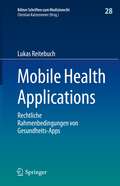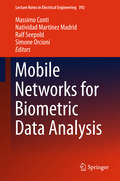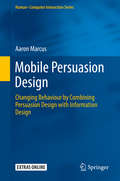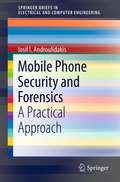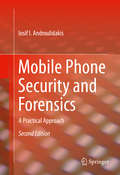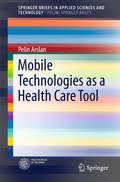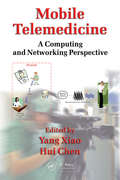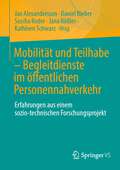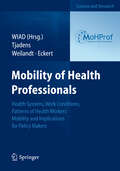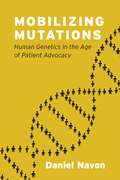- Table View
- List View
Mobile Health: Rethinking Innovation Management to Harmonize AI and Social Design (Future of Business and Finance)
by Kota Kodama Shintaro SengokuThis book examines the current status of mHealth development, regulations and the social background in Japan, South Korea and China, comparing it to the situation in the United States and the European Union and consider solutions to issues surrounding mHealth.The recent progress in mobile technology, represented by smartphones and smart watches, has been remarkable. A service called mobile health (mHealth), which uses such mobile technology to manage health, is also becoming a reality. Although the accuracy of medical devices is not as accurate as those used in medicine, the biometric information such as heart rate and SpO2 can already be monitored over a long period of time. Although the technology is maturing to the point where it can be implemented in society, it remains an unapproved service of medical care in most countries. The development and social implementation of mHealth is most active in the US, but social implementation is gradually progressing in other countries as well. In this book, we will first discuss what kind of global and harmonized regulations are desirable by comparing the regulatory reforms necessary for social implementation of mHealth. In addition, mHealth raises privacy concerns in the US because the usual behavior and biometric information of subjects is utilized by private companies. In addition, it is important to note that the behavior and biometric information of subjects collected by smart devices is automatically analyzed by AI technology, mainly machine learning, which makes the analysis a black box.
Mobile Health: Sensors, Analytic Methods, and Applications
by James M. Rehg Susan A. Murphy Santosh KumarThis volume provides a comprehensive introduction to mHealth technology and is accessible to technology-oriented researchers and practitioners with backgrounds in computer science, engineering, statistics, and applied mathematics. The contributing authors include leading researchers and practitioners in the mHealth field. The book offers an in-depth exploration of the three key elements of mHealth technology: the development of on-body sensors that can identify key health-related behaviors (sensors to markers), the use of analytic methods to predict current and future states of health and disease (markers to predictors), and the development of mobile interventions which can improve health outcomes (predictors to interventions). Chapters are organized into sections, with the first section devoted to mHealth applications, followed by three sections devoted to the above three key technology areas. Each chapter can be read independently, but the organization of the entire book provides a logical flow from the design of on-body sensing technology, through the analysis of time-varying sensor data, to interactions with a user which create opportunities to improve health outcomes. This volume is a valuable resource to spur the development of this growing field, and ideally suited for use as a textbook in an mHealth course.
Mobile Health Applications: Rechtliche Rahmenbedingungen von Gesundheits-Apps (Kölner Schriften zum Medizinrecht #28)
by Lukas ReitebuchDieses Buch beinhaltet eine Untersuchung der rechtlichen Rahmenbedingungen von Mobile Health Applications (mHealth-Anwendungen). Im Zuge der Digitalisierung des Gesundheitswesens halten Gesundheits-Apps vermehrt Einzug in die Gesundheitsversorgung. Ihr Einsatz ist für einen Großteil der Bevölkerung ein fester Bestandteil des Alltags geworden. Hersteller, Leistungserbringer aber auch die Patienten selbst stellen dabei große Erwartungen an die positiven Versorgungseffekte der Apps. Neue technische Errungenschaften bergen allerdings oftmals auch Risiken und Gefahren, stellen damit rechtliche Herausforderungen dar. Mit Inkrafttreten des Digitale‑Versorgung-Gesetzes und unmittelbarer Anwendbarkeit der EU-Medizinprodukteverordnung hat sich ein wesentlicher Teil des für mHealth‑Anwendungen maßgeblichen Regelungsgefüges grundlegend verändert. Die vorliegende Forschungsarbeit untersucht, inwieweit das Recht Innovationsoffenheit und Innovationsverantwortung in Bezug auf mHealth‑Anwendungen in einen gerechten Ausgleich bringen kann. Hierzu werden die einschlägigen Rechtsvorschriften aus dem Medizinprodukterecht, dem Haftungsrecht, dem Datenschutzrecht und dem Sozialversicherungsrecht einer eingehenden Analyse unterzogen und Vorschläge zur Weiterentwicklung des Rechtsrahmens unterbreitet.
Mobile Intensive Care Units: Advanced Emergency Care Delivery Systems (Anaesthesiologie und Intensivmedizin Anaesthesiology and Intensive Care Medicine #95)
by P. Rheindorf P. SandsEmergency care is improving throughout the world and thousands of lives are being saved each year. However, there are still too many patients who die before help reaches them in the form of advanced rescue and definitive emergency care techniques. In an effort to improve emergency care throughout the world, the International Committee of Emergency and Disaster Medicine meets bi annually. This meeting takes place in Mainz, Germany in September in order to discuss issues, exchange information, and establish re commendations designed to improve emergency care. The group is in~ dependent of political, national, racial, religious, or commercial influences and, in this sense, similar to the Club of Rome which attempts advances in sociology, biology and natural sciences. There fore, the organization could be called the "Club of Mainz" for the field of emergency and disaster medicine. The following book contains the proceedings of the International Symposiom on "Mobile Intensive Care Units and Advanced Emergency Care Units" at Mainz from September 24-27, 1973, and the discussions evoked by the first activities of the "Club of Mainz" and the inter nationally acknowledged "Recommendations". At this time we also announce the next meeting and International Symposium on Disaster Medicine, open to the public, organized by the "Club of Mainz" (October 1 - 2, 1977).
Mobile Medicine: Overcoming People, Culture, and Governance
by Sherri Douville"The healthcare industry is undergoing a transformation of exponential change and opportunity that bears daunting challenges. To incorporate groundbreaking technologies, we as leaders are building our people, skills, cultures, and leadership to capitalize on and refine those technologies to address the urgent needs of today and tomorrow. This timely work is written by a world-class multi-disciplinary team in Healthcare IT, medicine, and business. This breadth and collaboration is what's required to deliver this very timely cross-functional discussion and fantastic action planning resource. This book is required reading for any organization looking to lead the next wave of healthcare technology to improve care quality, patient safety, and clinician satisfaction to help us save more lives and keep people healthy across the entire care continuum." Aaron Miri Chief Information Officer for Dell Medical School and UT Health Austin & Co-Chair for the U.S. Department of Health and Human Services’ Federal Health IT Advisory Committee An actionable and practical resource to accelerate mobile computing in medicine: No topic in healthcare technology is more urgent and yet more elusive to date than mobile computing in medicine. It adheres to no boundaries, stagnates in silos, and demands not just the attention of dedicated professionals, but also teams of teams. A rich resource, this book shares hard-won lessons and primary research for better understanding, management, and execution of key mobile computing initiatives in medicine (that can save patient lives by reducing delays in medical information). It provides an action planning reference guide for mobile medicine stakeholders, including health system and insurance decision makers, clinicians, and investors. Foundational and groundbreaking in its knowledge set and combination, it also provides a unique and rare perspective, drawing from 27 distinct experts across disciplines from legal to medicine, informatics, organizational psychology, cybersecurity to engineering – the building blocks needed to catalyze a comprehensive mobile medicine strategy for your health system or investment thesis. Considering we lose a family member, colleague, or someone else every nine minutes due to a delay in medical information according to the Institute for Healthcare Improvement, this book makes significant strides in efficiently conveying foundational knowledge that can contribute to implementing mobile computing safely and cost-effectively while improving clinician and patient experiences in healthcare. These insights will accelerate the reader’s ability to conceptualize the real opportunities via mobile computing in medicine. FEATURES: Provides a current understanding of why the adoption of mobile medicine has been meager to date and what gaps and opportunities exist Delivers proven management and leadership techniques from experts doing the work of building IT, security, and informatics organizations and workflows in preparing for mobile medicine Describes how to navigate cultures of related professions essential to mobile medicine, including insights from physicians, engineers, informaticists, lawyers, IT researchers, organizational psychologists, board directors, researchers, cybersecurity leaders, and other key stakeholders Demystifies the latest, up-to-date federal rules, laws, and regulations impacting and enabling the promise of mobile medicine Highlights how to best mitigate risks for the development and deployment of mobile medicine and next-generation innovations, such as wearable robotics into the clinical environment Offers resources and tools to enable unprecedented collaboration across diverse professionals including, but not limited to, functional and work differences as well as skillsets and other factors of talent diversity required to bring mo
Mobile Medicine: Overcoming People, Culture, and Governance
by Sherri Douville"The healthcare industry is undergoing a transformation of exponential change and opportunity that bears daunting challenges. To incorporate groundbreaking technologies, we as leaders are building our people, skills, cultures, and leadership to capitalize on and refine those technologies to address the urgent needs of today and tomorrow. This timely work is written by a world-class multi-disciplinary team in Healthcare IT, medicine, and business. This breadth and collaboration is what's required to deliver this very timely cross-functional discussion and fantastic action planning resource. This book is required reading for any organization looking to lead the next wave of healthcare technology to improve care quality, patient safety, and clinician satisfaction to help us save more lives and keep people healthy across the entire care continuum." Aaron Miri Chief Information Officer for Dell Medical School and UT Health Austin & Co-Chair for the U.S. Department of Health and Human Services’ Federal Health IT Advisory Committee An actionable and practical resource to accelerate mobile computing in medicine: No topic in healthcare technology is more urgent and yet more elusive to date than mobile computing in medicine. It adheres to no boundaries, stagnates in silos, and demands not just the attention of dedicated professionals, but also teams of teams. A rich resource, this book shares hard-won lessons and primary research for better understanding, management, and execution of key mobile computing initiatives in medicine (that can save patient lives by reducing delays in medical information). It provides an action planning reference guide for mobile medicine stakeholders, including health system and insurance decision makers, clinicians, and investors. Foundational and groundbreaking in its knowledge set and combination, it also provides a unique and rare perspective, drawing from 27 distinct experts across disciplines from legal to medicine, informatics, organizational psychology, cybersecurity to engineering – the building blocks needed to catalyze a comprehensive mobile medicine strategy for your health system or investment thesis. Considering we lose a family member, colleague, or someone else every nine minutes due to a delay in medical information according to the Institute for Healthcare Improvement, this book makes significant strides in efficiently conveying foundational knowledge that can contribute to implementing mobile computing safely and cost-effectively while improving clinician and patient experiences in healthcare. These insights will accelerate the reader’s ability to conceptualize the real opportunities via mobile computing in medicine. FEATURES: Provides a current understanding of why the adoption of mobile medicine has been meager to date and what gaps and opportunities exist Delivers proven management and leadership techniques from experts doing the work of building IT, security, and informatics organizations and workflows in preparing for mobile medicine Describes how to navigate cultures of related professions essential to mobile medicine, including insights from physicians, engineers, informaticists, lawyers, IT researchers, organizational psychologists, board directors, researchers, cybersecurity leaders, and other key stakeholders Demystifies the latest, up-to-date federal rules, laws, and regulations impacting and enabling the promise of mobile medicine Highlights how to best mitigate risks for the development and deployment of mobile medicine and next-generation innovations, such as wearable robotics into the clinical environment Offers resources and tools to enable unprecedented collaboration across diverse professionals including, but not limited to, functional and work differences as well as skillsets and other factors of talent diversity required to bring mo
Mobile Networks for Biometric Data Analysis (Lecture Notes in Electrical Engineering #392)
by Massimo Conti Natividad Martínez Madrid Ralf Seepold Simone OrcioniThis book showcases new and innovative approaches to biometric data capture and analysis, focusing especially on those that are characterized by non-intrusiveness, reliable prediction algorithms, and high user acceptance. It comprises the peer-reviewed papers from the international workshop on the subject that was held in Ancona, Italy, in October 2014 and featured sessions on ICT for health care, biometric data in automotive and home applications, embedded systems for biometric data analysis, biometric data analysis: EMG and ECG, and ICT for gait analysis. The background to the book is the challenge posed by the prevention and treatment of common, widespread chronic diseases in modern, aging societies. Capture of biometric data is a cornerstone for any analysis and treatment strategy. The latest advances in sensor technology allow accurate data measurement in a non-intrusive way, and in many cases it is necessary to provide online monitoring and real-time data capturing to support a patient’s prevention plans or to allow medical professionals to access the patient’s current status. This book will be of value to all with an interest in this expanding field.
Mobile Persuasion Design: Changing Behaviour by Combining Persuasion Design with Information Design (Human–Computer Interaction Series)
by Aaron MarcusMobile Persuasion Design presents ten conceptual design projects (or ‘Machines’) for new mobile application's (smartphone or tablet with Web portals) that combine theories of persuasion and information design to change people’s behaviour. Areas such as the environment, health, learning and happiness are explored, looking at ways of marrying people’s wants and needs to make simple, usable and desirable mobile applications. A user-centred design approach has been used, adopting user experience (UX) methods, in-depth case studies and market analysis to see what a modern user needs from their mobile application. By applying concepts like persuasion theory and information architecture, try to find ways to satisfy these needs and positively change their user habits.In 2011, the Green, Health, and Money Machines won design awards in an international competition hosted by the International Institute for Information Design, Vienna.
Mobile Phone Security and Forensics: A Practical Approach (SpringerBriefs in Electrical and Computer Engineering)
by I.I. AndroulidakisMobile Phone Security and Forensics provides both theoretical and practical background of security and forensics for mobile phones. The author discusses confidentiality, integrity, and availability threats in mobile telephones to provide background for the rest of the book. Security and secrets of mobile phones are discussed including software and hardware interception, fraud and other malicious techniques used “against” users. The purpose of this book is to raise user awareness in regards to security and privacy threats present in the use of mobile phones while readers will also learn where forensics data reside in the mobile phone and the network and how to conduct a relevant analysis.
Mobile Phone Security and Forensics: A Practical Approach (Springerbriefs In Electrical And Computer Engineering Ser.)
by Iosif I. AndroulidakisThis new edition provides both theoretical and practical background of security and forensics for mobile phones. The author discusses confidentiality, integrity, and availability threats in mobile telephones to provide background for the rest of the book. Security and secrets of mobile phones are discussed including software and hardware interception, fraud and other malicious techniques used “against” users. The purpose of this book is to raise user awareness in regards to security and privacy threats present in the use of mobile phones while readers will also learn where forensics data reside in the mobile phone and the network and how to conduct a relevant analysis. The information on denial of service attacks has been thoroughly updated for the new edition. Also, a major addition to this edition is a section discussing software defined radio and open source tools for mobile phones.
Mobile Point-of-Care Monitors and Diagnostic Device Design (Devices, Circuits, and Systems)
by Walter KarlenEfficient mobile systems that allow for vital sign monitoring and disease diagnosis at the point of care can help combat issues such as rising healthcare costs, treatment delays in remote and resource-poor areas, and the global shortage of skilled medical personnel. Covering everything from sensors, systems, and software to integration, usability, and regulatory challenges, Mobile Point-of-Care Monitors and Diagnostic Device Design offers valuable insight into state-of-the-art technologies, research, and methods for designing personal diagnostic and ambulatory healthcare devices. Presenting the combined expertise of contributors from various fields, this multidisciplinary text: Gives an overview of the latest mobile health and point-of-care technologies Discusses portable diagnostics devices and sensors, including mobile-phone-based health systems Explores lab-on-chip systems as well as energy-efficient solutions for mobile point-of-care monitors Addresses computer vision and signal processing for real-time diagnostics Considers interface design for lay healthcare providers and home users Mobile Point-of-Care Monitors and Diagnostic Device Design provides important background information about the design process of mobile health and point-of-care devices, using practical examples to illustrate key aspects related to instrumentation, information processing, and implementation.
Mobile Point-of-Care Monitors and Diagnostic Device Design (Devices, Circuits, and Systems #31)
by Walter Karlen, Krzysztof IniewskiEfficient mobile systems that allow for vital sign monitoring and disease diagnosis at the point of care can help combat issues such as rising healthcare costs, treatment delays in remote and resource-poor areas, and the global shortage of skilled medical personnel. Covering everything from sensors, systems, and software to integration, usability, and regulatory challenges, Mobile Point-of-Care Monitors and Diagnostic Device Design offers valuable insight into state-of-the-art technologies, research, and methods for designing personal diagnostic and ambulatory healthcare devices. Presenting the combined expertise of contributors from various fields, this multidisciplinary text: Gives an overview of the latest mobile health and point-of-care technologies Discusses portable diagnostics devices and sensors, including mobile-phone-based health systems Explores lab-on-chip systems as well as energy-efficient solutions for mobile point-of-care monitors Addresses computer vision and signal processing for real-time diagnostics Considers interface design for lay healthcare providers and home users Mobile Point-of-Care Monitors and Diagnostic Device Design provides important background information about the design process of mobile health and point-of-care devices, using practical examples to illustrate key aspects related to instrumentation, information processing, and implementation.
The Mobile Receptor Hypothesis: The Role of Membrane Receptor Lateral Movement in Signal Transduction (Molecular Biology Intelligence Unit)
by David A. JansMobile Technologies as a Health Care Tool (SpringerBriefs in Applied Sciences and Technology)
by Pelin ArslanThis book presents a state-of-the-art overview of the available and emerging mobile technologies and explores how these technologies can serve as support tools in enhancing user participation in health care and promoting well-being in the daily lives of individuals, thereby reducing the burden of chronic disease on the health care system. The analysis is supported by presentation of a variety of case studies on the ways in which mobile technologies can be used to increase connectivity with health care providers and relevant others in order to promote healthy lifestyles and improve service provision. Detailed information is also provided on a sample project in which a set of tools has been used by teens at risk of obesity to record their sociopsychological environment and everyday health routines. Specifically, it is evaluated whether video diaries, created using a mobile platform and shared in real time via a social network, assist subjects in confronting obesity as a chronic disease. The book will be of interest to all who wish to understand the impressive potential of mobile health or to conduct research in the field.
Mobile Technologies for Smart Healthcare System Design (Wireless Networks)
by Xiaonan Guo Yan Wang Jerry Cheng Yingying (Jennifer) ChenThis book offers a comprehensive examination of mobile technologies in healthcare. It starts by covering wireless solutions, including WiFi signals and mmWave technology for activity recognition, fitness assistance, and eating habit monitoring. The discussion extends to wearable technologies that focus on personal fitness and injury prevention, highlighting the innovative use of PPG sensors in wearables, which enable gesture recognition and user authentication. Based on thorough analyses on the challenges of designing robust mobile healthcare systems, this book addresses the difficulty of gathering accurate and reliable sensor data amidst the variability of human activities. It explores solutions using advanced sensing modalities, such as WiFi, mmWave, and PPG sensors, and robust algorithms for feature extraction to interpret activities, gestures, and biometrics. It also tackles system robustness across diverse environments and practical issues such as reducing training efforts, handling motion artifacts, and the implementation of these systems using commercially available devices. The primary audience for this book targets computer science students and researchers working in mobile computing, smart healthcare, human-computer interaction and artificial intelligence/machine learning. Professionals and consultants focused on advancing mobile-based healthcare solutions will want to purchase this book as a reference.
Mobile Telemedicine: A Computing and Networking Perspective
by Yang Xiao Hui ChenThe concept of medical treatment from a distance (in absentia care) is actually quite ancient, dating back to tribal days where smoke signals were used to warn of serious disease in a community. Nowadays, telemedicine is used to facilitate treatment in rural areas, where the nearest doctor is miles away, through various forms of information
Mobilität und Epilepsie
by J. Bauer G.-D. Burchard S. SaherEpilepsien gehören zu den häufigsten chronischen Erkrankungen des zentralen Nervensystems und betreffen mit einer Prävalenz von 1% einen recht hohen Teil der Bevölkerung. Epilepsien sind nicht nur unmittelbar durch die Anfälle von Bedeutung, sie sind es auch mittelbar, weil sie Probleme im Alltag des Kranken mit sich bringen können, die für den Betroffenen eine erhebliche Einschränkung bedeuten. Dies betrifft insbesondere die Fahrtauglichkeit und ihre psychosozialen Folgen. Mit der zunehmenden Mobilität und Reisetätigkeit gewinnen die speziellen Risiken der an Epilepsie erkrankten Menschen Bedeutung für die Aufklärung durch den behandelnden Arzt. Dazu gehören insbesondere Reisesicherheit, Sport und Impfung. Diese Monographie bietet hierzu die wesentlichen Fakten und gibt Ratschläge für die individuelle Beratung des Patienten.
Mobilität und Gesundheit: Einfluss der Verkehrsmittelnutzung auf die Gesundheit Berufstätiger (BestMasters)
by Juliane KemenJuliane Kemen stellt den internationalen Forschungsstand zur Schnittstelle berufsbedingter Mobilität und der Arbeitnehmergesundheit vor. Darauf aufbauend entwickelte sie eine Studie, im Rahmen derer sie 2.351 Arbeitnehmer in Deutschland zur Verkehrsmittelnutzung auf dem Arbeitsweg und mehreren Gesundheitsindikatoren befragte. Die Autorin stellte Zusammenhänge zwischen der Verkehrsmittelnutzung und Krankheitstagen, BMI und dem Wohlbefinden fest. Ein Großteil der berufstätigen Bevölkerung legt zweimal täglich einen Arbeitsweg zurück und hat durch die Verkehrsmittelwahl einen großen Einfluss auf das Stadtbild, die Umwelt und die eigene Gesundheit. Daher sind die entwickelten Handlungsempfehlungen auch für viele Unternehmen oder politisch Tätige interessant.
Mobilität und Teilhabe – Begleitdienste im öffentlichen Personennahverkehr: Erfahrungen aus einem sozio-technischen Forschungsprojekt
by Jan Alexandersson Daniel Bieber Sascha Roder Jana Rößler Kathleen SchwarzDas Mobilitätsprojekt „mobisaar“ verbessert die Teilhabe von mobilitätseingeschränkten Menschen und Menschen mit Behinderungen durch den Einsatz von Lots*innen und mit Technikunterstützung durch Apps. Das in vier saarländischen Landkreisen erfolgreich umgesetzte BMBF-Projekt wird nach 5 Jahren Laufzeit 2020 finalisiert und bietet einen guten Einblick in die Konzepte, Strukturen und Schulungsideen des kostenfreien Begleitdienstes im kleinsten Flächenland Deutschlands sowie dessen Auswirkungen auf den ÖPNV.
Mobilities and Health
by Anthony C. GatrellLooking at health and health care in a new way, this book examines health risks and benefits as encountered 'on the move' rather than focusing on the risks and benefits incurred at fixed locations. The provision and utilization of health care is also investigated, as produced/delivered and consumed/accessed in mobile settings. Engaging with the contemporary concern with 'mobilities' this book covers many forms of movement and flow, including movements of people, disease, information and health care. The issues and problems which are considered - whether re-emerging infections, displaced persons, or the 'risks' of globalised travel - are of current and ongoing concern. Drawing on three main disciplines, geography, sociology, and epidemiology, author Tony Gatrell makes strong connections between these areas of inquiry, drawing on (for example) social theorising, geographical concepts, and epidemiological methods and data. The book will be of interest to the growing number of geographers working on the geography of health, along with social scientists involved in the mobilities 'turn'. More broadly, as issues of global public health that invariably involve the movements of people, goods, viruses and information continue to hit the headlines, the book is both timely and of policy relevance.
Mobilities and Health
by Anthony C. GatrellLooking at health and health care in a new way, this book examines health risks and benefits as encountered 'on the move' rather than focusing on the risks and benefits incurred at fixed locations. The provision and utilization of health care is also investigated, as produced/delivered and consumed/accessed in mobile settings. Engaging with the contemporary concern with 'mobilities' this book covers many forms of movement and flow, including movements of people, disease, information and health care. The issues and problems which are considered - whether re-emerging infections, displaced persons, or the 'risks' of globalised travel - are of current and ongoing concern. Drawing on three main disciplines, geography, sociology, and epidemiology, author Tony Gatrell makes strong connections between these areas of inquiry, drawing on (for example) social theorising, geographical concepts, and epidemiological methods and data. The book will be of interest to the growing number of geographers working on the geography of health, along with social scientists involved in the mobilities 'turn'. More broadly, as issues of global public health that invariably involve the movements of people, goods, viruses and information continue to hit the headlines, the book is both timely and of policy relevance.
Mobility and Transport for Elderly and Disabled Patients
by Claes-Eric Norrbom Agneta StahlFirst Published in 1991. This is Volume 13 in a series of Transportation Studies. It contains 2 parts of the proceedings of a Conference held at Stockholmsmassan, Alvsjo, Sweden, 21-24 May 1989, organized by the Swedish Board of Transport in co-operation with the Department of Traffic Planning and Engineering, Lund Institute of Technology.
Mobility and Transport for Elderly and Disabled Patients
by Claes-Eric Norrbom Agneta StahlFirst Published in 1991. This is Volume 13 in a series of Transportation Studies. It contains 2 parts of the proceedings of a Conference held at Stockholmsmassan, Alvsjo, Sweden, 21-24 May 1989, organized by the Swedish Board of Transport in co-operation with the Department of Traffic Planning and Engineering, Lund Institute of Technology.
Mobility of Health Professionals: Health Systems, Work Conditions, Patterns of Health Workers' Mobility and Implications for Policy Makers
by Frits Tjadens Caren Weilandt Josef EckertThis book on mobility of health professionals reviews, analyses and summarises published information and data as well as collected interview data from stake holders, including politicians, policy makers, health service managers and migrant health workers. It is based on the research carried out under the umbrella of the EU-funded project “Mobility of Health Professionals (MoHProf).The partners involved in the MoHProf project gathered evidence from 25 countries around basic questions and knowledge gaps relating to the international migration of health professionals, which involved an analysis of migration flows and evaluation of policies addressing migration. This book provides a comprehensive description and analysis of the mobility streams, the motives and driving forces behind them and the impact on and challenges for health systems and draws conclusions and provides recommendations for future strategic planning, monitoring and the management of mobility of health professionals as well as further research and policy development needs.
Mobilizing Mutations: Human Genetics in the Age of Patient Advocacy
by Daniel NavonWith every passing year, more and more people learn that they or their young or unborn child carries a genetic mutation. But what does this mean for the way we understand a person? Today, genetic mutations are being used to diagnose novel conditions like the XYY, Fragile X, NGLY1 mutation, and 22q11.2 Deletion syndromes, carving out rich new categories of human disease and difference. Daniel Navon calls this form of categorization “genomic designation,” and in Mobilizing Mutations he shows how mutations, and the social factors that surround them, are reshaping human classification. Drawing on a wealth of fieldwork and historical material, Navon presents a sociological account of the ways genetic mutations have been mobilized and transformed in the sixty years since it became possible to see abnormal human genomes, providing a new vista onto the myriad ways contemporary genetic testing can transform people’s lives. Taking us inside these shifting worlds of research and advocacy over the last half century, Navon reveals the ways in which knowledge about genetic mutations can redefine what it means to be ill, different, and ultimately, human.


